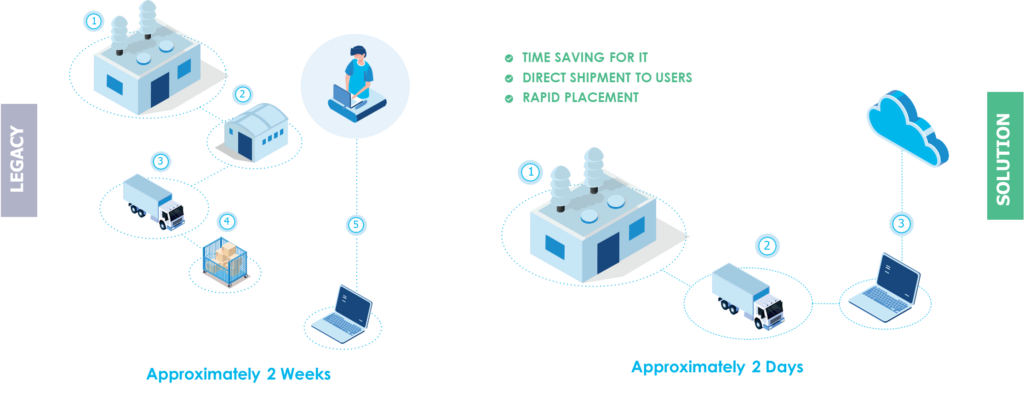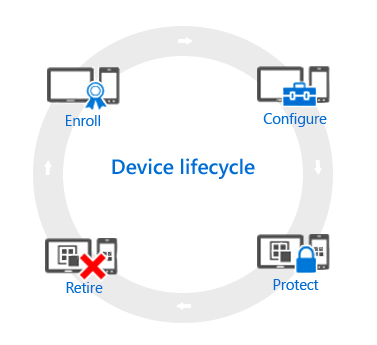
“Often a new staff member’s first experience in a company is arriving in the office on their first day and being told that their device is not ready for them.”
Legacy IT operations evolved to maintain security and control in a complex environment. Employees mostly worked on their desktops in an office connected to a local server and data center. It was a world of cables, and IT support was often in the same building.
IT staff were busy people, doing not very interesting, but essential work, as opposed to staying up with the play with innovations, consulting, and advising on how to solve business problems. Zero-Touch Provisioning for Windows, Macs, iPhones, iPads, and Android devices is a game-changer.
Today we live in a world of digital natives. Most people today not only have a laptop, they have a corporate smartphone and perhaps also a tablet. They also have BYOD devices that they use to access business information and applications. They expect to be able to use these devices anywhere, at any time.
What does Zero Touch Provisioning do?
Zero Touch Provisioning frees valuable IT resources and gets employees productive faster.
Hear Denis O’Shea, founder of Mobile Mentor, explain how Zero Touch Provisioning gets devices in the hands of employees faster, without cumbersome image management and manual provisioning from IT.
Onboarding New Staff
Often a new staff member’s first experience in a company is arriving in the office on their first day and being told that their device is not ready for them, or the hardware is there but not all of the applications are running. The induction processes require that they have access to their new computers so the first day, or longer, becomes one of mutual frustration between management, staff, and the IT person, who is now under time and emotional pressure.
A survey by Webonboarding with OnePoll found that 46% of new staff had negative experiences when joining a new company, such as their computer not being ready for them. New people are often digital natives and reasonably expect things to be prepared for them on day one.
The Excitement of the New Device
A similar experience often occurs when existing staff members finally get their new computer or smartphone. They look forward to working on their shiny new device, but the process dictates that they can’t start using it until the old one is no longer on the network. But often, when it is, they find some of the applications are not working correctly.
Files that are not on network drives need to be moved from one laptop to the other, and issues such as missing network printers, or Wi-Fi not working need to be rectified. Meanwhile, the clock is ticking. Work needs doing, and people are getting frustrated.
Time is Money
Whether it is an SME company, a large corporation, or government, the costs of integrating new devices are high and unsustainable in today’s world. The consequences of computer problems are significant and, sadly, all too common.
According to an article by Help Net Security in July 2020, “Enterprise IT teams are failing to deliver a positive remote employee experience.” The report adds that research shows the speed of change has left legacy IT tools ineffective at managing remote endpoints and the digital employee experience. The study exposes some powerful results.
37%
of employees are experiencing more issues working remotely since the advent of COVID19.
72%
are reporting that it takes days and weeks to get fixed.
68%
of employees report being disrupted by the service desk.
31%
were able to continue their work during the process.
26%
could not work at all while an issue was being dealt with by the service desk.
Remote Working, COVID19, and the Great Digital Transformation
Many workers were traditionally office-bound much of the time because of the limitations of their computers and telecommunications. Being stuck at a desk in an office limited productivity. Those legacy models of IT operations are no longer fit for purpose. For Mobile Mentor clients, those barriers are no longer an issue.
Even before the COVID19 pandemic, remote work was one of the most significant changes to business as usual. Open-plan offices, hot desking, and wireless communications challenged the structure of the workplace. IT operations were caught in the middle, supporting legacy structures, while at the same time working to enable mobility.
The COVID19 lockdowns added to this complexity. Many people were stuck at home, unable to access their networks effectively, including IT!
Zero-Touch Provisioning is making it possible for companies to respond to the rapidly changing nature of the workplace.
University of Tennessee Knoxville
The University of Tennessee Office of Information Technology called in Mobile Mentor to provide them with an Intune service to remotely provision travel laptops for staff spread out across seven campuses, eleven colleges, and people in 95 counties across the state.
Prior to the engagement, the Office of IT used different tools and processes to provision Windows, Mac, iOS, and Android devices. The manual process required the creation and maintenance of images with packages of applications and drivers. Intricate work that needed to be done by a skilled IT team.
Mobile Mentor delivered a working use case for travel laptops using Zero Touch Provisioning through Microsoft Intune.
Then COVID19 took hold, and the priorities changed. The solution was then successfully used to configure hundreds of new Windows computers at speed to support faculty and staff who needed to be able to work from home.
“From a security perspective, we are in a much better place because of the Zero-Touch Provisioning project, and the COVID-19 situation really accelerated our journey from a proof-of-concept to full production.“
– Bob Hillhouse: Chief Information Security Officer (CISO)
Zero Touch Provisioning from Mobile Mentor
Our Zero Touch Provisioning service isn’t just for Windows laptops. We can configure Windows 10, macOS, iOS, iPadOS, and Android operating systems for zero touch.
Here are a few of the technologies used.
MICROSOFT INTUNE
Mobile Mentor provides Zero-Touch Provisioning through Microsoft Intune, a cloud-based MDM, and MAM. It is a Microsoft solution, but businesses are not limited to the Windows platform. People will use a variety of platforms, with the best fit for purpose, and a practical solution needs to be agnostic of operating systems.
Microsoft Intune features specific versions for education and the US Government that are tailor-made to their needs and consistent with policies and regulatory requirements.
MICROSOFT AUTOPILOT
Microsoft Autopilot provides zero-touch management of Windows 10 devices. Windows Autopilot eliminates the need to image machines and the maintenance that comes with it. Windows devices can be shipped directly from the factory to the employee, who simply turns them on, signs in, connects to the Internet, and lets the automated setup process begin.
APPLE BUSINESS MANAGER
Apple Business Manager (ABM) is an online portal for IT administrators who deploy Mac OS and iOS devices in an enterprise or educational setting. The portal is used in conjunction with a third-party mobile device (MDM) software solution for managing and distributing these Apple devices and applications.
ANDROID ENTERPRISE AND SAMSUNG KNOX
Android Enterprise is a Google-led Enterprise Mobility Management (EMM) solution, which allows configurations to be pushed out to devices. Android Enterprise includes support for locked down, managed mode for corporate-owned devices as well as containerized configurations for BYOD devices, securely separating work from personal applications and functionality.
Samsung Knox is the manufacturer’s solution for Samsung Android smartphones, designed to maximize control for both Android and any unique features offered within the Samsung product environment.
Cut Out the Middleman
Instead of having each purchased device shipped to IT for manual provisioning, it can go straight from the factory or warehouse to the user in their workplace, whether that is an office or their home.
Now we can configure a laptop, phone, or tablet, over-the-air. Zero-Touch Provisioning has many benefits:
-
It simplifies device life-cycle management. Whether it is a new device to be used by someone for the very first time, or the replacement of equipment that is at the end of life, it does not have to be physically seen or touched by IT.

-
The device life-cycle overheads and related infrastructure costs are reduced, delivering savings in time and money.
-
Employees can start using their devices when they need them, not when someone has time to set the device up.
Hard and Soft Cost Reductions
There are many savings to be enjoyed by Zero-Touch Provisioning.
-
A reduction in the cost of server infrastructure and VPN licenses improves the bottom line.
-
IT helpdesk and administration staff are freed up from having to maintain and deploy devices physically.
-
Used laptops can be reset over the air, and do not have to be returned to IT first.
-
Stress levels are reduced both for IT and the employee, and productivity is improved.
-
Emotional comfort levels of new staff increase, because of smooth onboarding. They will feel they have joined a professional organization.
-
Replacing dropped, broken, or lost devices are quick and easy.
-
Buffer stocks can be maintained close to the locations where they may be needed.
What Our Clients Have to Say
ALIVE HOSPICE
Alive Hospice is an excellent example of Zero-Touch Provisioning in practice. In addition to their live-in hospice centers, Alive provides an environment where people, who prefer to, can receive palliative care in the comfort of their own homes and surroundings.
Clinicians receive an iPad delivered without IT having to touch or open the box before the device is dispatched to the customer. Application updates can be pushed remotely without the need to visit the office. Some mobile care workers can also have laptops or other devices sent directly to their locations, saving time and travel.
Serving more than 3,600 patients and their families annually, Zero-Touch Provisioning has enormous benefits for Alive Hospice.
“This has been nothing short of amazing for us and the patients in our care.”
– Kyle Rucker: Director of Information Technology
Navigating the New Normal
The old model of procuring devices, manually setting each one up, and then providing them to staff is no longer desirable. In fact, because of workplace changes due to the COVID19 pandemic, for many companies, it is now impractical.
When COVID19 becomes a memory, the workplace will not simply return to business as usual. The flexibility of being able to work from anywhere, on any device, at any time (A³) will become the norm.
Zero-Touch Provisioning saves time, stress, and money, not just when a new device is acquired and setup, but throughout the life cycle of devices and apps.
Corporate IT will continue to remain a critical function, but they will be able to focus on innovation, productivity, and business support. Perhaps the tasks that attracted people to the role in the first place.
Conclusion
Zero-Touch Provisioning is one of the 6 pillars of Modern Endpoint Management and for many businesses, it is the start of a transformative journey.

Zero Touch Provisioning
Order and ship devices directly to your employees with automated configuration out-of-box. No more imaging!
We leverage Microsoft 365 technologies to reduce your costs while increasing security and delighting your employees.





